Very near to being world’s best electoral system
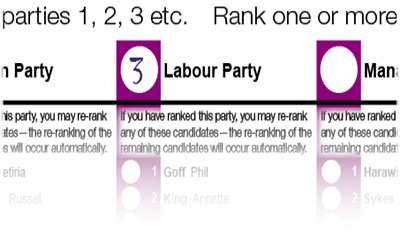
As submitted to the Electoral Commission
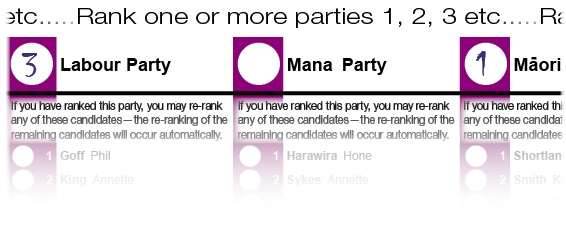
Figure 1: The party vote is all-important in determining which parties are in a position to form a government. Yet in 2011, 7.46% of the votes cast—almost 150 000 of them—were cast for parties that failed to reach the 5% threshold. By permitting voters to fully express their party preferences, votes that would otherwise be wasted would be seamlessly transferred to the voter’s next preference. Party ballot mock-up Mahurangi Magazine
The Mahurangi Magazine has campaigned for MMP to be retained and improved for four and a half years—‘1 2 3, tune-up MMP.’
This submission primarily addresses an inherent historical deficiency of mixed member proportional systems—the lack of preference voting. The submission then briefly addresses the questions specifically raised by the review.
The Mahurangi Magazine strongly supports the essential proportional functionality of the mixed member system. But the system predates, by more than half a century, the 2001 breakthrough that facilitated the routine use of preference voting. It is impossible to overstate the importance of that achievement, because without preference voting, no system can now be considered wholesomely and robustly democratic. A voter should, for example, be entitled to give her first preference to a minor party in the secure knowledge that her second preference given to a major party will take effect, should her first preference fail to assist the minor party.
The 2001 breakthrough by New Zealander Stephen Todd, and this review, provides Aotearoa with the opportunity to refine mixed member proportional to produce the world’s fairest and most user-friendly electoral system—a high-tech export opportunity of enormous economic potential, and of incalculable global civic benefit.
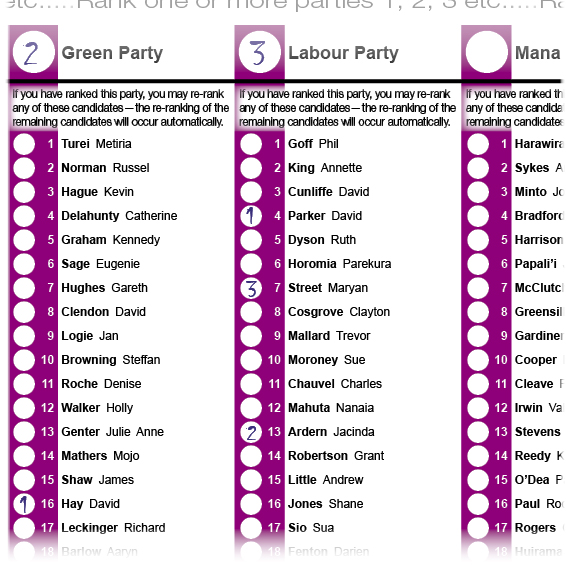
Figure 2: While ‘above or below the line’ ballots are used elsewhere in voting systems featuring party lists, the use of a default party-determined list, as illustrated here, would be a world first, and along with its prowess with preference voting would allow Aotearoa to market and advise on the most user-friendly and democratic electoral systems and services available. Note Only those party re-rankings that accompany preferences actually utilised would be given effect, otherwise voters could influence the lists of parties other than those they support. Party ballot concept Mahurangi Magazine
Beginning with the user-friendly aspect: Because of the periodic nature of voting, it is of fundamental importance that the ballot format be entirely intuitive—studies consistently show that ballot complexity results in lower voter turnout, and that the mixed member system is particularly poorly understood. Figure 1 focuses on the all-important party vote. The layout, necessarily, assumes a paper-based ballot—an electronic format would allow for a truly intuitive interface. The prime difference, setting aside the horizontal layout, is the allowance for voters to rank two or more parties, rather than being constrained to tick a maximum of one. This provision means that if a voter’s first or subsequent party of choice failed to reach the threshold, the vote would be transferred, in all likelihood to a party that succeeded in being represented. In the last election, 148 882 votes (7.46%) were cast for parties that failed to reach the 5% threshold.
Figure 2 reveals the reason for the horizontal arrangement. This is fundamentally the ‘above or below the line’ ballot layout used in systems elsewhere where voters are permitted to tick above the line to accept the party list or to rank party list candidates themselves. But in this far more user-friendly form, the voter can help tweak the party ranking without undertaking the otherwise laborious business of ordering ludicrous numbers of candidates—Labour’s 2011 party list included 70 placings; National’s, 75.
Political parties will submit that list ranking must remain the exclusive prerogative of the party. This ignores the universal reality that party membership is a fringe activity, and not always for reasons of apathy—many people are professionally disqualified from party membership. It is inherently undemocratic to impose immutable list rankings on voters—to force voters to accept a party’s ranking or not support that party. Provided that a person’s party vote benefits that party, there can be no justification for not allowing that person to participate in the final ranking of its list candidates.
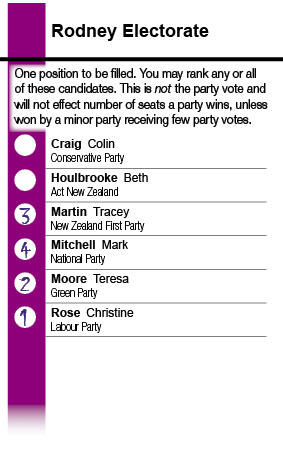
Figure 3: The electorate ballot should never have been paired with the party ballot. The current side-by-side format is a throwback to the original used to elect representatives to the German Bundestag, whereby voters were allowed only a single tick for an electorate candidate that was inextricably paired with their party. Electorate ballot concept Mahurangi Magazine
Figure 3 illustrates the proposed new electorate ballot, which differs from the current in three important aspects. Firstly, the electorate ballot should always have been independent of the party ballot, to avoid the perception of a ‘proper vote’ being two ticks along the same row, for a matching party and party electorate candidate. The side-by-side arrangement currently used is a throwback to the original German ballot where voters could cast one vote only—one tick—for a candidate and that candidate’s party.
Secondly, as with the proposed party ballot, ranking is permitted. First-past-the-post voting is only ever appropriate where there are just two candidates. At least four electorates claimed by National last year would have been represented by Labour, had the second preferences of Green Party supporters been taken into account. Thanks to the correction provided by mixed member proportional, this doesn’t alter the ratio of seats that the parties hold in Parliament, but it nevertheless represents an unnecessary and undemocratic aberration of the right to be locally represented by the person preferred by the greatest number of local voters.
Thirdly, aside from it sometimes interfering with the election of the most preferred local representative, first-past-the-post magnifies the imbalance that must be corrected by the allocation of list seats. While New Zealanders greatly value the strict proportionality of the mixed member proportional system, the initial overly large number of list seats (60) was massively unpopular, with 81.47% voting in 1999 for Parliament to be reduced back to a total of 99 representatives. A happy by-product of allowing electorate candidates to be ranked is that it would appreciably reduce the demand for list seats to achieve proportionality.
Returning to the need for user-friendliness: Wherever the mixed member proportional system is used, a high level of confusion prevails as to the relative importance of the party and electorate votes. A common mistake is for voters to support the party with the electorate vote and to give the all-important party vote to their second party preference. No amount of experience with mixed member proportional, or voter education, will do much to remedy this tendency, but nor is it necessary. By permitting voters to rank both party and electorate candidates, the need to learn counter-intuitive behaviour evaporates. This is the most important benefit than would accrue from the proposed changes, because it would contribute significantly to addressing the decline in voter turnout.
Specific review issues
Thresholds
The 5% party vote threshold for a party to be eligible for the allocation of list seats should be reduced. The current threshold is high by international standards, and has proved too onerous, as witnessed by the difficulty both the Green and the New Zealand First parties have experienced in attempting to avoid the oblivion the results from falling below 5%.
The Mahurangi Magazine strongly commends adoption of the graduated threshold devised by Stephen Todd, whereby a party would be eligible for one list member on reaching a threshold of say 3%, through to full proportionality of upon reaching say 5%.
The coattails provision—the one-electorate seat threshold for a party to be eligible for allocation of list seats—is inherently unfair and has thus proved to be enormously unpopular to the point of bringing the electoral system itself into disrepute. It was originally devised for the needs of a much more populous country, Germany, where regionally-based minor parties would otherwise face too steep a struggle for representation. Adoption of the Stephen Todd graduated threshold would render the one-electorate seat threshold redundant.
By-election candidates
No electorate member should be permitted to contest a by-election, as that would be an obvious travesty—an abdication of the contract to serve an electorate for the elected term. A list member, however, has no such contract and should be available, without first resigning, to represent an electorate, if that be the decision of the electorate’s voters. A list position so vacated should be filled automatically from the party list.
Dual candidacy
The capacity of a person to be both a constituency candidate and a list candidate should be retained. Electorate voters have the right to determine who does or does not represent their electorate, but not to dictate who might represent, as a list member, a party they oppose.
The proposed provision whereby voters may participate in the ranking of list members of parties they support, fully addresses the need for party lists to be democratically determined.
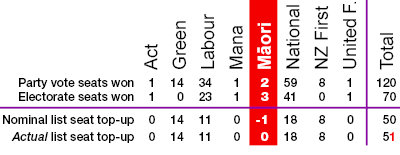
Figure 5: The anomaly whereby an extra seat results from the Māori Party’s ability to win electorate seats, but not party vote share, is an aberration hardly worth fixing, much less fixating upon, and not even in Bolivia or Lesotho, where no overhang is tolerated, are electorate seats taken off a party. chart Mahurangi Magazine
Democratic list ranking
As proposed, the party’s responsibility should be limited to determining the default order of candidates on its party list ballot. It should be the inalienable right of voters to rank list candidates in order of preference, but for this to be practicable, and as proposed, voters should be permitted to re-rank as few as they wish, and not be compelled to rank entire party lists.
Proportion of electorate seats to list seats
As proposed, preference voting would minimise the number of list seats required to achieve proportionally. This would mean that the effects of population growth on the ratio of electorate seats to list seats would be even less than currently forecast.
Overhang
Figure 5 illustrates the poorly understood phenomena of the overhang. Mixed member proportional, as its name suggests, places equal importance on party proportionality and local representation. It achieves proportionality by topping up the electorate seats won by the respective parties, with list seats—it could, but does not, reallocate hard-won electorate seats.
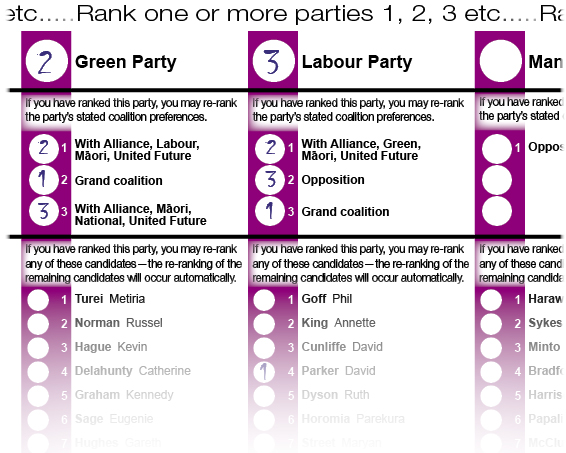
Figure 6: While voters are comfortable with coalition government, parties are finding it difficult to play nicely, and remained locked in power struggles reminiscent of the despised two-party duopoly. The solution is to extend democracy to allow the electorate determine the makeup of coalitions, and in fact to provide voters with the power to demand that grand coalitions be formed, when the other coalitions on offer are found wanting. Coalition ranking concept Mahurangi Magazine
The proportional system was introduced to break the stranglehold of the two-party system, which had substantially lost the respect of the electorate. If anything, the change was brought about by a widespread disillusionment with party politics, not by a desire to enshrine and further-empower the parties. So while proportionality is at the core of mixed member proportional, it would be a colossal aberration if party proportionality waswere, in the submission allowed to dictate the size of Parliament, by ensuring strict proportionality for the smallest parties represented. To eliminate any overhang in respect to the Māori Party result in the 2011 election, Parliament would have needed to be enlarged to 222 seats. It is most unlikely that even those most exercised by the so-called overhang of Māori seats would be keen to see 101 additional seats in Parliament. Ultimately the responsibility of ensuring that small parties don’t enjoy undue influence rests with Parliament.
Although the Māori–National coalition could be seen to be currently benefiting from the overhang, the Labour party vote is benefiting at the expense of the Māori party vote. If this was not the case and National was the beneficiary, it is easy to see how this could result in the difference as to which major party was in a position to form a government. This highlights the obvious and dangerous deficiency of all systems that facilitate coalition government, the absence of the means whereby voters can determine the makeup of a coalition. Figure 6 suggests how this long-overdue deficiency could be readily addressed, thereby removing perhaps the most corrosive and deeply undemocratic aspects of coalition-producing proportional electoral systems.
Conclusion
Through the courage of the 1986 royal commission, Aotearoa has one of world’s fairest electoral systems, but one that would nevertheless benefit greatly from the work pioneered locally perfecting preference voting. As Thomas Jefferson put it:
…the remedy for the ills of democracy is more democracy.
